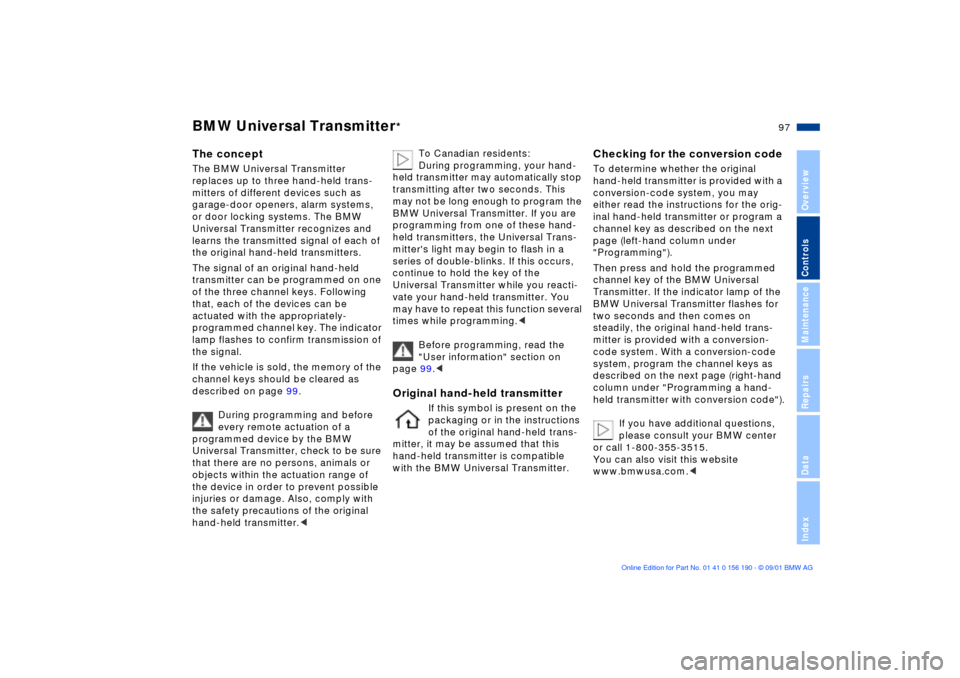2002 BMW 330Ci CONVERTIBLE automatic transmission
[x] Cancel search: automatic transmissionPage 73 of 159

73n
OverviewControlsMaintenanceRepairsDataIndex
Cruise control
*
To deceleratePress button (Ð) briefly:
If you are already driving with active
cruise control, the speed is decreased
by approx. 0.6 mph (1 km/h) every time
you tap the button.
Press and hold button (Ð):
With the cruise control active, the
system automatically reduces the
throttle opening to slow the vehicle.
When you release the button, the
system maintains and stores the
current speed.
To interrupt the cruise controlWhen the system is activated, press the
button. The indicator lamp stays on.
You can use the cruise control again
whenever you want by calling up the
speed that was stored last.
In addition, cruise control is interrupted
automatically:
>When the brakes are applied
>When you apply pressure to the
clutch pedal, or when you move the
automatic transmission selector lever
from D to N
>If you exceed or fall below the
programmed speed for an extended
period (by depressing the acceler-
ator, for example).
To call up the stored speedPress the button:
The vehicle accelerates to and main-
tains the last speed stored.
Page 97 of 159

97n
OverviewControlsMaintenanceRepairsDataIndex
BMW Universal Transmitter
*
The concept The BMW Universal Transmitter
replaces up to three hand-held trans-
mitters of different devices such as
garage-door openers, alarm systems,
or door locking systems. The BMW
Universal Transmitter recognizes and
learns the transmitted signal of each of
the original hand-held transmitters.
The signal of an original hand-held
transmitter can be programmed on one
of the three channel keys. Following
that, each of the devices can be
actuated with the appropriately-
programmed channel key. The indicator
lamp flashes to confirm transmission of
the signal.
If the vehicle is sold, the memory of the
channel keys should be cleared as
described on page 99.
During programming and before
every remote actuation of a
programmed device by the BMW
Universal Transmitter, check to be sure
that there are no persons, animals or
objects within the actuation range of
the device in order to prevent possible
injuries or damage. Also, comply with
the safety precautions of the original
hand-held transmitter.<
To Canadian residents:
During programming, your hand-
held transmitter may automatically stop
transmitting after two seconds. This
may not be long enough to program the
BMW Universal Transmitter. If you are
programming from one of these hand-
held transmitters, the Universal Trans-
mitter's light may begin to flash in a
series of double-blinks. If this occurs,
continue to hold the key of the
Universal Transmitter while you reacti-
vate your hand-held transmitter. You
may have to repeat this function several
times while programming.<
Before programming, read the
"User information" section on
page 99.<
Original hand-held transmitter
If this symbol is present on the
packaging or in the instructions
of the original hand-held trans-
mitter, it may be assumed that this
hand-held transmitter is compatible
with the BMW Universal Transmitter.
Checking for the conversion code To determine whether the original
hand-held transmitter is provided with a
conversion-code system, you may
either read the instructions for the orig-
inal hand-held transmitter or program a
channel key as described on the next
page (left-hand column under
"Programming").
Then press and hold the programmed
channel key of the BMW Universal
Transmitter. If the indicator lamp of the
BMW Universal Transmitter flashes for
two seconds and then comes on
steadily, the original hand-held trans-
mitter is provided with a conversion-
code system. With a conversion-code
system, program the channel keys as
described on the next page (right-hand
column under "Programming a hand-
held transmitter with conversion code").
If you have additional questions,
please consult your BMW center
or call 1-800-355-3515.
You can also visit this website
www.bmwusa.com.<
Page 121 of 159

121n
OverviewControlsMaintenanceRepairsDataIndex
Engine oilChecking oil level1. Park the vehicle on a level surface
2. Switch the engine off after it has
reached normal operating tempera-
ture
3. After approx. 5 minutes, pull the
dipstick out and wipe it off with a
clean lint-free cloth, paper towel, or
similar material
4. Carefully push the dipstick all the
way into the guide tube and pull it
out again
5. The oil level should be between the
two marks on the dipstick.
As with fuel economy, oil consumption
is directly influenced by your driving
style and vehicle operating conditions.
The oil volume between the two marks
on the dipstick corresponds to approx.
1.1 US quarts (1 liter). Do not fill beyond
the upper mark on the dipstick. Excess
oil will damage the engine.
Adding engine oilWhile you should wait until the level has
dropped to just above the lower mark
before adding oil, you should never
allow the oil level to fall below this
mark.
BMW engines are designed to
operate without oil additives; the
use of additives could lead to damage
in some cases. This is also true for the
manual transmission, the automatic
transmission, the differential, and the
power steering system.<
Recommendation: have the oil changed
at your BMW center.
Page 135 of 159

135n
OverviewControlsMaintenanceRepairsDataIndex
Changing a wheel
Safety precautions for replacing
flat tires and all wheel changes:
Stop the vehicle as far as possible from
passing traffic. Park on a firm, flat,
surface. Switch on the hazard warning
flashers. Turn the steering wheel to the
straight-ahead position and engage the
steering lock. Shift into 1st or reverse
(selector lever in Park with automatic
transmission) and engage the parking
brake.
All passengers should be outside the
vehicle and well away from your imme-
diate working area (behind a guardrail,
for example).
If a warning triangle or portable hazard
warning lamp is available, set it up on
the roadside at an appropriate distance
from the rear of the vehicle. Comply
with all safety guidelines and regula-
tions.
Change the wheel only on a level, firm
surface which is not slippery. Avoid
jacking the vehicle on a soft or slippery
support surface (snow, ice, loose
gravel, etc.), as either the vehicle or the
jack could slip sideways.
Position the jack on a firm support
surface.
Do not place wooden blocks or similar
objects under the jack. They could
prevent the jack from extending to its
full height and reduce its support
capacity.
Do not lie under the vehicle or start the
engine when the vehicle is supported
by the jack Ð risk of fatal injury.<
Your BMW is equipped with a space-
saver spare tire designed for temporary
use in maintaining the vehicle's mobility
in an emergency.
To remove the space-saver spare
tire, lift the floor panel in the
luggage compartment completely out,
refer to page 35.<
What you will needIn order to avoid rattling noises later,
note the position of the tools when you
remove them and return them to their
original position when you are through
using them.
>Jack 1
Raise the floor panel in the luggage
compartment, refer to page 35 and
undo the jack (arrow).
When you have completed work, fold
the handle back and insert it in its
holder
>Chock 2
Located behind the jack on the wall
in the luggage compartment. Loosen
the wingnut to remove it
Page 146 of 159

146n
Weights
BMW 325Ci BMW 330Ci
Curb weight (with one person, ready for operation, full tank of fuel, options not included)
with manual transmission
with automatic transmissionlbs. (kg)
lbs (kg)3,560 (1,615)
3,627 (1,645)3,616 (1,640)
3,704 (1,675)
Approved gross vehicle weight
with manual transmission
with automatic transmissionlbs (kg)
lbs (kg)4,442 (2,015)
4,509 (2,045)4,497 (2,040)
4,575 (2,075)
Approved front axle loads lbs (kg) 2,083 (945) 2,094 (950)
Approved rear axle loads lbs (kg) 2,546 (1,155) 2,579 (1,170)
Approved maximum roof weight for the hardtop lbs (kg) 165 (75) 165 (75)
Luggage compartment capacity
with the convertible top compartment raisedcu ft (l)
cu ft (l)9.2 (260)
10.6 (300)9.2 (260)
10.6 (300)
Never exceed either the approved axle loads or the approved gross vehicle weight.
Page 147 of 159

147n
OverviewControlsMaintenanceRepairsDataIndex
Capacities
Notes
Fuel tank
Reserve gal. (liters)
gal. (liters)approx. 16.6 (approx. 63)
approx. 2.1 (approx. 8)Fuel specification, refer to
page 23
Windshield/headlamp washer reservoir quarts (liters) approx. 5.6 (approx. 5.3) Specifications, refer to page 120
Cooling system including heating circuit quarts (liters) approx. 8.9 (approx. 8.4) Specifications, refer to page 123
Engine oil and filter change quarts (liters) approx. 6.9 (approx. 6.5) BMW High Performance
Synthetic Oil
Specifications, refer to page 121
Manual and automatic transmission
and differentialÐ Lifetime lubricant, no oil change
required
Page 150 of 159

Everything from A to ZA
ABS (Antilock Brake
System)19, 109
Access to the rear51
Accessories10
Activated-charcoal filter96
Adaptive Transmission
Control (ATC)68
ADB (Automatic Differential
Brake)81
Adding
brake fluid124
coolant123
engine oil121
washer fluids120
Adjusting
electric power seats49
head restraints50
lumbar support50
mirrors55
steering wheel54
Air conditioning90
temperature setting91
Air distribution91, 94
Air nozzles90
Air outlets
ventilation90, 93 Air supply91, 94
Airbags18, 56
sitting correctly48
Alarm system28, 36
Antifreeze and anti-
corrosion agents123
disposal123
Antilock Brake System
(ABS)19, 109
Anti-theft system28, 29, 32
Aquaplaning109
Armrest99
ASC+T (Automatic Stability
Control plus Traction)80
Ashtray
front100
rear101
ATC (Adaptive Transmission
Control)68
Attach vehicle vacuum
cleaner101
AUC (Automatic recircu-
lated-air control)95
Automatic climate
control93, 94
Automatic cruise control72 Automatic Differential Brake
(ADB)81
Automatic dimming feature,
mirrors56
Automatic headlight
control87
Automatic recirculated-air
control (AUC)95
Automatic Stability Control
plus Traction (ASC+T)80
Automatic transmission67
Automatic transmission with
Steptronic18, 67
Average fuel
consumption78
Average speed78
Axle loads146
B
Backup lamps66
bulb replacement133
Battery139
care139
charging139
disposal139
Battery charge current
indicator17 Belts, safety52
Beverage holder100
Blower91, 94
BMW High Performance
Synthetic Oil122
BMW Maintenance
System125
BMW sports seat,
adjustment49
BMW Universal
Transmitter97
Bore144
Bottle holder, refer to
beverage holder100
Brake fluid124
disposal124
warning lamp17, 124
Brake fluid level109
Brake hydraulic system,
warning lamp17
Brake lamps
bulb replacement133
Brake pads19
A-Z
Page 155 of 159

Everything from A to Z
155n
OverviewControlsMaintenanceRepairsDataIndex
Seats48
adjustment48
adjustment
precautions48
Securing cargo103
Securing child-restraint
system59
Selector lever, automatic
transmission67
Service and Warranty Infor-
mation Booklet (US
models)125
Service Interval
Display75, 125
Setting the temperature91
Shiftlock67
Side airbags56
Sitting correctly with
airbags48
Ski bag102
Socket for electrical
appliances101
Spare key28
Spare tire135
Speedometer15
Sports seat, adjustment49
Standing lamps88
Starting the engine64 Steering wheel lock64
Stopping the vehicle65
Storage compartments99
Stowing cargo103
Stroke144
Switching off the engine65
Symbols8
Synthetic oils122
T
Tail lamps
bulb replacement133
Tank capacity147
Technical data144
Technical
modifications10, 126
Telephone preparation100
Temperature display
outside temperature77
Temperature gauge
engine coolant75
Temperature
layering92, 95
Temperature setting91, 94
Third brake light134 Tilt alarm sensor37
operating via remote
control30
switching off37
Tire change135
Tire condition113
Tire inflation
pressures24, 113
checking24
indicator83
monitoring83
Tire inflation pressures
table25
Tire Pressure Monitor
(RDC)83, 115, 138
Tire pressures24
refer also to tire inflation
pressures
Tire replacement114
Tire tread113
Tires108
Tools130
Torque144
Tow fittings141
Towing the vehicle141
Track145
Transmission66 Transmitter keys28
Transporting children
safely59
Tread depth, tires113
Tread wear113
Trip odometer74
Trunk lid, refer to luggage
compartment lid33
Trunk, refer to luggage
compartment35
Turn signal
indicators20, 69
Turn signals
bulb replacement132
Turning radius145
U
Uniform Tire Quality
Grading115
Universal Transmitter97
Use antifreeze, radiator123 V
Vehicle keys28
Vehicle Memory63
Vehicle weight146
Vehicle, starting64
Ventilation90, 93
draft-free92, 95